Glycolysis Fill In The Blank
Glycolysis is a catabolic pathway in the living cells. It occurs in the cytosol of a cell and converts glucose into pyruvate. It is derived from the Greek words; glykys, sweetness, and lysis, significant breakdown. Embden, Meyerhof, and Parnas described this pathway. Hence, information technology is as well called the Embden-Meyerhof pathway (EM pathway).
Definition
Glycolysis is a serial of reactions for the breakup of Glucose (a 6-carbon molecule) into 2 molecules of pyruvate (a 3-carbon molecule) under aerobic atmospheric condition; or lactate under anaerobic weather forth with the production of a small corporeality of free energy.
Introduction
- Glycolysis is a sequence of ten steps that extracts free energy from glucose molecules.
- It is the first step towards glucose metabolism.
- It occurs in both aerobic and anaerobic weather condition.
- In aerobic states, pyruvic acid enters the citric acid cycle. It undergoes oxidative phosphorylation that leads to ATP production.
- In anaerobic states, pyruvic acrid converts to lactic acid, and the internet production of two ATP molecules occurs.
- A single glucose molecule consumes two ATP molecules and produces 4 ATP, two NADH, and two pyruvates. This pyruvate molecule is used in the citric acid cycle or as a precursor for other reactions.
Difference between Glycolysis and Gluconeogenesis
| Glycolysis | Gluconeogenesis |
| Information technology is a series of reactions that converts glucose into pyruvate. | It is a serial of reactions that produces glucose from non-sugar molecules. |
| It is a catabolic process. | Information technology is an anabolic process. |
| The raw material used is glucose. | The raw material used is lactate and amino acids. |
| Occurs only in the cytoplasm. | Occurs both in the cytoplasm and mitochondria. |
| It has a series of ten reactions | Two essential irreversible steps volition exist bypassed by iv new reactions |
Difference between Glycolysis and Citric acid wheel (Krebs cycle/TCA cycle)
| Glycolysis | Citric acid bicycle (Krebs cycle/TCA cycle) |
| A series of reactions that convert glucose molecule into ii pyruvate molecules | A series of reactions that convert pyruvate molecules into Acetyl CoA so CO2 and Water. |
| It is the first footstep of cellular respiration. | It is the 2nd footstep of cellular respiration. |
| It occurs in both aerobic and anaerobic respiration. | It occurs only in aerobic respiration. |
| It occurs in the cytoplasm. | It occurs in mitochondria. |
| It is a linear process. | Information technology is a cycle. |
| The cease product is an organic substance. | The terminate production is an inorganic substance. |
| Produces two NADH, two ATPs, and two Pyruvate molecules. | Produces half dozen NADH and 2 FADH2 molecules. |
| It consumes two ATP molecules. | Information technology consumes no ATPs. |
| The net gain is 08 ATPs. | The cyberspace proceeds is 24 ATPs. |
| CO2 is non released. | CO2 is released. |
| Don't utilise O2. | Uses O2. |
Biochemical significance of Glycolysis
- It is a pregnant route for carbohydrate metabolism
- It takes identify in all the cells of the trunk
- It is the but pathway that tin can human action in an aerobic and anaerobic environment.
- Skeletal muscles can survive because of anaerobic glycolysis.
- Glycolysis is the just source of free energy in erythrocytes.
- The majority of glycolytic pathway reactions are reversible, which is essential for gluconeogenesis or the formation of new glucose.
Clinical significance of Glycolysis
- Pyruvate kinase enzyme deficiency is an autosomal recessive disorder that causes hemolytic anemia.
- Arsenic replaces phosphate in glycolysis steps, which is why arsenic poisoning prevents ATP synthesis.
- Exercise intolerance is caused by muscle Phosphofructokinase deficiency.
Types of Glycolysis
There are two main types of glycolysis; aerobic and anaerobic.
Aerobic Glycolysis
Aerobic means in the presence of oxygen. Aerobic glycolysis occurs when oxygen is sufficient. First, glucose is converted into pyruvate, and then pyruvate will be oxidized to the final products CO2 and Water.
Anaerobic Glycolysis
Anaerobic ways in the absence of oxygen. First, glucose is converted into pyruvate and so pyruvate into lactate.
Phases of Glycolysis
There are 2 primary phases of glycolysis.
- The energy-requiring stage (Preparatory phase)
- The energy-releasing stage. (Payoff stage)
Glucose-requiring stage (Preparatory Phase)
- This phase is also called the glucose activation phase. In this phase of glycolysis, two molecules of ATP are invested, and the hexose chain is broken into 2 triose phosphates.
- During this phase, the phosphorylation of glucose and its conversion to glyceraldehyde-three-phosphate occurs.
Energy-releasing phase (Payoff Stage)
- This phase is also chosen the free energy extraction phase. During this phase, the conversion of glyceraldehyde-3-phosphate to pyruvate takes place.
- In this process, one NADH and two ATP molecules are formed.
Equation of Glycolysis
The following equation well summarizes the process of glycolysis:
C6H12O6 + 2ADP + 2Pi + 2NAD+ → 2C3H4O3 + 2H2O + 2ATP + 2NADH + 2H+
C6H12O6 is glucose and C3H4O3 is pyruvate. ADP and NAD stand for Adenosine diphosphate and Nicotinamide adenine dinucleotide, respectively.
Steps of Glycolysis
Glycolysis is a lengthy process. It has the following steps.
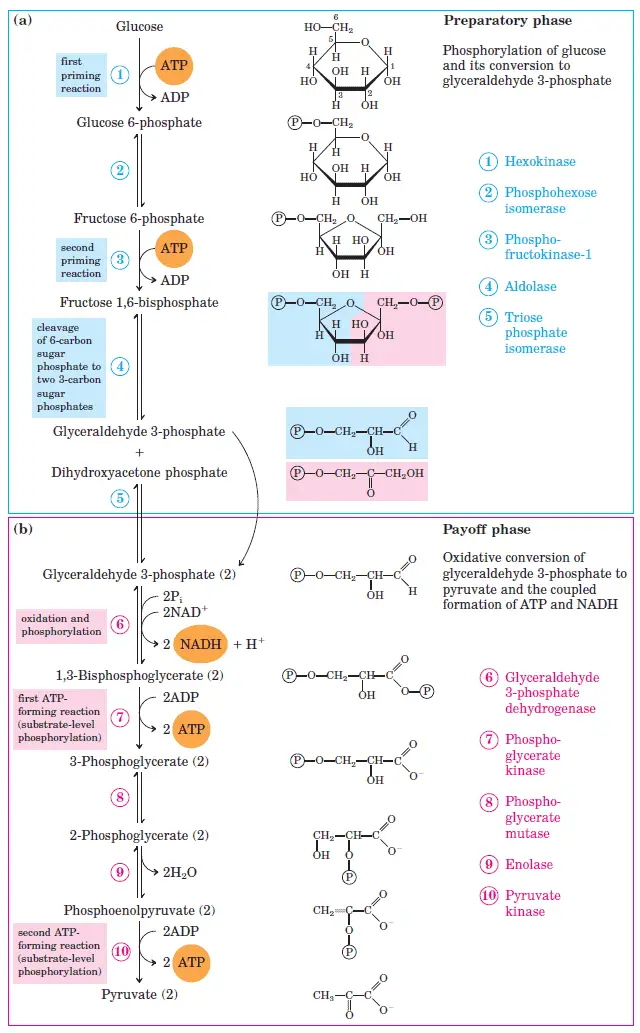
Step ane : Uptake and Phosphorylation of Glucose
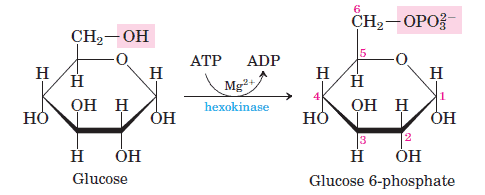
- Glucose is phosphorylated to form glucose-six-phosphate.
Hexokinase
- Phosphate grouping is transferred from ATP to Glucose.
- It is an irreversible footstep
- Hexokinase has a loftier affinity for glucose
- Mg2+ is the cofactor in this reaction
- Hexokinase is a key glycolytic enzyme.
- Glucose is phosphorylated to course glucose-6-phosphate.
Glucokinase
- It is present in the liver, where information technology removes the glucose from the portal vein following a meal.
- Also present in pancreatic cells, where it releases insulin.
- It acts but when claret glucose is more than than 100mg/dL.
- Glucokinase has a high affinity for glucose
Step 2 : Isomerization of Glucose-6-Phsphate to Fructose-half dozen-Phosphate
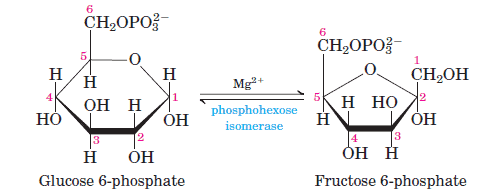
- Glucose-six-phosphate is isomerized to fructose-6-phosphate by phosphohexose isomerase.
- For the reaction to accept place, information technology needs the assist of aldose-ketose isomerization using a catalyst phosphohexose isomerase.
- It causes the glucopyranose ring's opening to a linear structure irresolute the structure of the furanose ring of fructose-half dozen-phosphate.
Step 3 : Phosphorylation of F-6-P to Fructose ane,6-Biphosphate

- Fructose-vi-phosphate is further phosphorylated to fructose 1,6-bisphosphate.
- The enzyme is phosphofructokinase-one. It catalyzes the transfer of a phosphate grouping from ATP to fructose-6-phosphate.
- Information technology volition be the second irreversible step.
- It is a major regulatory step of glycolysis.
- I ATP is utilized in this step.
- Phosphofructokinase-1 is the key enzyme in glycolysis that regulates the breakdown of glucose.
- Information technology is also called the bottleneck or committed step of glycolysis.
Footstep iv : Cleavage of Fructose 1,6-Biphosphate

- The six-carbon fructose-1,6-bisphosphate is broken into 2 iii-carbon compounds; one glyceraldehyde-three-phosphate (GAP) and some other i is dihydroxyacetone phosphate (DHAP).
- The enzyme which catalyzes the reaction is aldolase. Since the astern reaction is an aldol condensation, the enzyme is called aldolase.
- The reaction is reversible.
Stride v : Interconversion of the Triose Phosphates
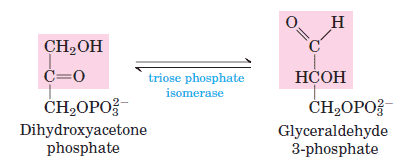
- GAP is on the direct pathway of glycolysis, whereas DHAP is not. Hence Triose-phosphate isomerase converts DHAP into GAP useful for generating ATP. Thus cyberspace consequence is that glucose is at present cleaved into ii molecules of glyceraldehyde-3-phosphate.
- This reaction is rapid and reversible.
Pace 6 : Oxidative phosphorylation of GAP to 1,3-Bisphosphoglycerate

- The beginning step in the payoff phase is the oxidation of glyceraldehyde three-phosphate to a high-energy compound, one,3-bisphosphoglycerate.
- This reaction is catalyzed past glyceraldehyde 3-phosphate dehydrogenase.
- It is an energy-yielding reaction. During this reaction, NAD+ is reduced and NADH is generated past adding inorganic phosphate.
- This is a reversible reaction.
- Under aerobic atmospheric condition, NADH enters into mitochondria.
- Under anaerobic atmospheric condition, NADH is utilized by Lactate Dehydrogenase.
Step 7 : Conversion of one,iii-Biphosphoglycerate to three-Phosphoglycerate

- The enzyme 1,3-bisphosphoglycerate kinase transfers the high-energy phosphoryl group from the carboxyl grouping of one,three-bisphosphoglycerate to ADP, forming ATP and iii-phosphoglycerate.
- The ane,3-bisphosphoglycerate kinase is the just kinase in glycolysis that is reversible.
- This is a unique example where ATP can exist produced at the substrate level without participating in the electron ship concatenation. This blazon of reaction where ATP is formed at substrate level is called Substrate level phosphorylation.
Stride eight : Conversion of 3-Phosphoglycerate to 2-Phosphoglycerate

- 3-phosphoglycerate is isomerized to two-phosphoglycerate by shifting the phosphate group from third to 2nd carbon atom.
- The enzyme is phosphoglycerate mutase.
- This is a readily reversible reaction.
- Mg2+ is essential for this reaction.
Step ix : Dehydration of ii-Phosphoglycerate to Phosphoenolpyruvate
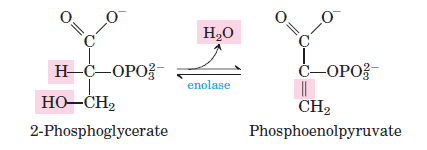
- 2-phosphoglycerate is converted to PhosphoenolPyruvate
- The enzyme used is Enolase that requires Mg++.
- The step involves dehydration and one h2o molecule is removed.
- A loftier-free energy phosphate bail is produced. The reaction is reversible.
Step 10 : Conversion of Phosphoenol Pyruvate to Pyruvate
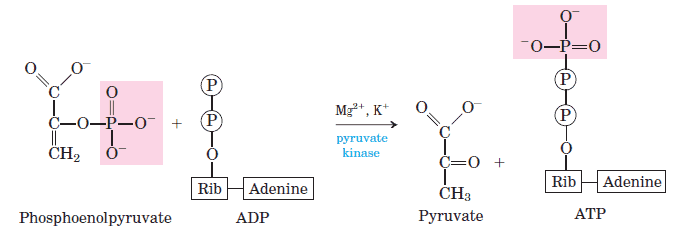
- Phosphoenolpyruvate (PEP) is dephosphorylated to pyruvate, by pyruvate kinase.
- It will exist the 2d substrate-level phosphorylation.
- One mole of ATP is generated during this reaction.
- This pace is irreversible.
Additional Pace in Anaerobic Condition
When animal tissues cannot be supplied with sufficient oxygen to support aerobic oxidation of the pyruvate and NADH produced in glycolysis, NAD+ is regenerated from NADH by the reduction of pyruvate to lactate.
Some tissues and jail cell types (such as erythrocytes, which have no mitochondria and thus cannot oxidize pyruvate to CO2) produce lactate from glucose fifty-fifty nether aerobic weather condition.
The reduction of pyruvate is catalyzed by lactate dehydrogenase.
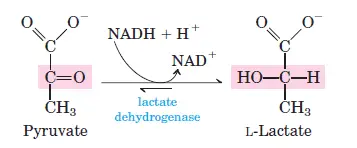
Fates of pyruvate
The fate of pyruvate depends on the organism and metabolic weather condition. It tin exist one of the following iii
Alcohol fermentation
It occurs in yeast. In anaerobic states, pyruvate is converted to ethanol and CO2.
Lactic acid fermentation
In the cells like skeletal muscle cells, pyruvate is reduced into lactate. It occurs in anaerobic weather.
Oxidation
In the presence of oxygen, pyruvate is moved to the mitochondria, where it is oxidized into acetyl Co-A. It further goes into the citric acid cycle and converts to CO2 and H2O.
Net free energy (ATP) yield per molecule of Glucose in Glycolysis
Energy Yield in Aerobic Glycolysis
| Stride | Enzyme | Source | No. of ATP |
|---|---|---|---|
| i | Hexokinase | – | -i |
| 3 | Phosphofructokinase | – | -1 |
| six | Glyceraldehyde-3- phosphate dehydrogenase | NADH | (+3) x 2 = +6 |
| 7 | Phosphoglycerate kinase | ATP | (+1) x 2 = +2 |
| 10 | Pyruvate kinase | ATP | (+ane) x 2 = +2 |
| Internet Yield | eight ATPs |
Energy Yield in Anaerobic Glycolysis
| Stride | Enzyme | Source | No. of ATP Formed/consumed |
|---|---|---|---|
| 1 | Hexokinase | – | -1 |
| 3 | Phosphofructokinase | – | -one |
| vii | Phosphoglycerate kinase | ATP | (+ane) x 2 = +2 |
| ten | Pyruvate kinase | ATP | (+1) x 2 = +2 |
| Net Yield | ii ATPs |
Oft Asked Questions
Q ane. How many ATPs are produced in aerobic glycolysis?
At the end of the aerobic glycolysis procedure, a total of seven (08) ATPs are produced.
Q 2. How many ATPs are produced in anaerobic glycolysis?
At the end of the anaerobic glycolysis procedure, a total of ii (2) ATPs are produced.
Q 3. Where does glycolysis occur?
Glycolysis occurs in the cell's cytoplasm. It takes place in the cytosol of the cell. In aerobic states, the pyruvic acrid volition enter the mitochondria where oxidative phosphorylation will occur. In anaerobic states, the pyruvic acrid will stay in the cytoplasm where the enzyme lactate dehydrogenase volition convert it to lactate.
Q 4. What is the end product of glycolysis?
The end products of glycolysis are 2 ATPs, two NADH, and 2 pyruvates.
Q 5. How a defect in the procedure of glycolysis leads to anemia?
Pyruvate kinase enzyme deficiency leads to hemolytic anemia. There volition be an disability to course ATPs which causes cell damage. These cells are taken upward by the spleen which leads to splenomegaly. The signs and symptoms of hemolytic anemia include jaundice, icterus, elevated bilirubin level, and enlarged spleen.
Q 6. Is glycolysis aerobic or anaerobic?
The glycolysis procedure itself is anaerobic, but after finishing the glycolysis procedure, the cell volition go along respiration, which can move in the management of aerobic or anaerobic. The selection primarily depends on the circumstances of the cell.
Q 7. What are the functions of glycolysis?
1. It is the pathway of all cells in the body.– It is the main source of energy for the ruddy blood cells.
two. It supplies the cells ample levels of oxygen when performing strenuous activities.
3. It gives carbon skeletons for not-essential amino acid synthesis.
iv. It is vital for the formation of new glucose.
Q 8. Does glycolysis occur in all cells?
Glycolysis occurs in both eukaryotic and prokaryotic cells.
Q 9. What are the tissues that depend mainly on glucose every bit metabolic fuel?
1. Mature erythrocytes
2. Pare
3. White fibers of skeletal muscle
4. Brain
5. Renal medulla
6. GIT
Q 10. What are the irreversible steps of glycolysis?
one. Hexokinase
2. Pyruvate kinase
iii. Phosphofructokinase
Q 11. What is Glucose?
Glucose is a hexose sugar. It is an essential molecule for the encephalon, retina, as well as for erythrocytes. Glucose is a monosaccharide molecule that has six carbon atoms and vi oxygen atoms.
An aldehyde grouping is fastened to the first carbon atom. The remaining five carbons have one hydroxyl group each. Glucose vi-phosphate is the specific class of glucose that is used in the process of glycolysis.
Q 12. What enzymes are used in glycolysis?
There are ten enzymes that are used in this process.
ane. Hexokinase
2. Phosphoglucoisomerase
3. Phosphofructokinase
four. Aldolase
5. Phosphotriose isomerase
6. Glyceraldehyde 3-phosphate dehydrogenase
seven. Phosphoglycerate kinase
8. Phosphoglycerate mutase
9. Enolase
x. Pyruvate kinase
Q xiii. Can glycolysis occur without oxygen?
As it is stated above that the process of Glycolysis requires no oxygen. Information technology is anaerobic respiration that is performed past all cells of the body, including anaerobic cells.
Glycolysis Fill In The Blank,
Source: https://laboratoryinfo.com/glycolysis-steps-diagram-energy-yield-and-significance/
Posted by: harrisfroplithe.blogspot.com


0 Response to "Glycolysis Fill In The Blank"
Post a Comment